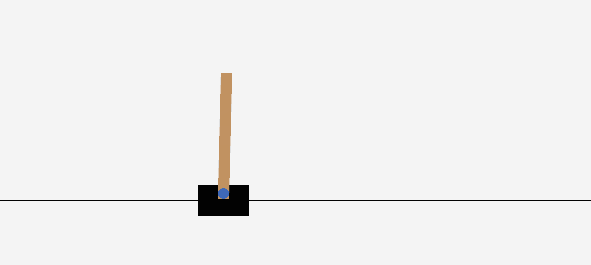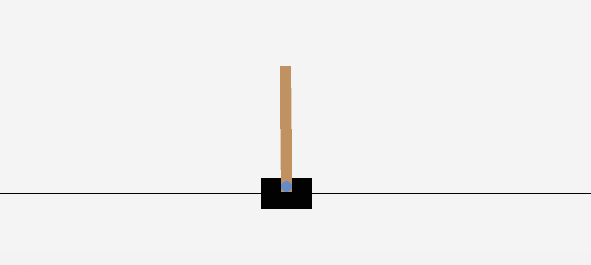深度Q学习算法
理论
深度Q学习算法(Deep Q-Learning Algorithm)是将 Q 表格替换为神经网络的 Q 学习算法,由 DeepMind 的 Mnih et al. [1][2]提出。
Q表格本质上是一个函数 $f: S\times A \rightarrow \mathbb{R}$,我们自然也可以使用神经网络构造这个函数,让它可以处理连续的状态和动作。此外,使用神经网络还有一个好处:我们可以向神经网络输入实例信息 $m\in M$ ,使之可以跨实例学习函数 $f: M\times S\times A\rightarrow \mathbb{R}$ 。也就是说,Agent可以将其在实例 $m_1,m_2,\ldots~m_n$上 学习到的经验迁移到未曾见过的实例 $m_{n+1}$ 上,增强模型的泛化性能,减少其探索新实例所需的时间。
网络更新方程的设计
(以 Bellman 方程 为基础):
$$Q(s_t, a_t) \leftarrow (1-\eta) Q(s_t, a_t) + \eta(\gamma\max_{j\in A} Q(s_{t+1}, j) + r_t)$$
求更新前与更新后的差分:
$$\Delta Q(s_t, a_t) = -\eta Q(s_t, a_t) + \eta(\gamma\max_{j\in A} Q(s_{t+1},j) + r_t)$$
即:
$$\Delta Q(s_t, a_t) = \eta(\gamma\max_{j\in A} Q(s_{t+1},j) + r_t - Q(s_t, a_t))$$
在理想情况下充分训练时,应当有
$$\lim_{t\rightarrow \infty}\Delta Q(s_t, a_t) = 0$$
也就是说,训练的目标应当是最小化 $\Delta Q(s_t, a_t)$,即目标函数为:
$$L(\theta) = \mathrm{MSE}(Q(s_t, a_t),~\gamma\max_{j\in A} Q(s_{t+1},j) + r_t)$$
其中的 $\mathrm{MSE}$ 也可以替换为其它的损失函数。
实现
下面以CartPole-v1环境为例编写训练程序。
引入相关的库以及定义一些超参数:
1
2
3
4
5
6
7
8
9
10
11
12
| from random import random, randint
import gymnasium as gym
import torch
import torch.nn as nn
from tqdm import tqdm
n_actions = 2
n_states = 4
lr = 3e-4
discount = 0.95
batch_size = 128
epochs = 5000
|
定义神经网络,这里定义了一个简单的三层神经网络,其中输出层没有添加激活函数是因为激活函数会限制网络的值域至 $R_{act}$ ,设Q函数的值域是 $R_Q$,$R_Q\nsubseteq R_{act}$ 时损失函数难以收敛,影响训练效果:
1
2
3
4
5
6
7
8
9
10
11
12
13
14
15
16
| class Net(nn.Sequential):
norm_vector = torch.tensor([0.5, 1.0, 0.21, 0.5])
def __init__(self, in_feats = n_states, out_feats = n_actions, hidden = 32):
super().__init__(
nn.Linear(in_feats, hidden),
nn.SiLU(),
nn.Linear(hidden, hidden),
nn.SiLU(),
nn.Linear(hidden, out_feats),
)
def forward(self, state):
x = state/self.norm_vector # 归一化
y = super().forward(x)
return y
|
定义网络、优化器与损失函数:
1
2
3
| net = Net()
optimizer = torch.optim.AdamW(net.parameters(), lr=lr, amsgrad=True)
criterion = nn.SmoothL1Loss() # 发现L1的效果比L2要好
|
训练过程(原环境提供的 reward 恒为 1,信息太少,因此这里改用自定义的 reward,在倾角过大或位置过远时进行惩罚):
1
2
3
4
5
6
7
8
9
10
11
12
13
14
15
16
17
18
19
20
21
22
23
24
25
26
27
28
29
30
31
32
33
34
35
36
37
38
39
40
41
42
43
44
| env = gym.make("CartPole-v1")
state, info = env.reset()
for t in tqdm(range(epochs)):
# 前向传播
loss = 0.0
epsilon = 1 - t / epochs # 动态调整epsilon
for _ in range(batch_size):
# 选择action =========================
row = net(state)
if random() < epsilon: # exploration
action = randint(0, n_actions-1)
else:
action = row.squeeze().argmax().item()
# 执行action =========================
state, reward, terminated, truncated, info = env.step(action)
# 使用自定义的reward
reward = -20.0 if terminated else 0
if abs(state[2]) > 0.1: # 限制倾角
reward += -1.0
if abs(state[0]) > 0.3: # 限制位置
reward += -2.0
if reward >= 0:
reward = 1.0
# 计算loss =========================
with torch.no_grad():
if terminated:
curr_q = torch.tensor(reward)
else:
curr_q = net(state).max() * discount + reward
loss += criterion(row[action], curr_q)
if terminated or truncated:
state, info = env.reset()
# 反向传播
optimizer.zero_grad()
(loss/batch_size).backward()
torch.nn.utils.clip_grad_value_(net.parameters(), 1)
optimizer.step()
env.close()
# 保存checkpoint
torch.save(net.state_dict(), "cartpole.ckpt")
|
推理:
1
2
3
4
5
6
7
8
9
10
11
| env = gym.make("CartPole-v1", render_mode="human")
state, info = env.reset()
with torch.no_grad():
for t in range(2000):
row = net(state)
action = row.squeeze().argmax(0).item()
print(row)
state, reward, terminated, truncated, info = env.step(action)
if terminated or truncated:
state, info = env.reset()
env.close()
|
不出意外的话,运行程序后可以看到类似于这样的动画,说明这个算法以及我们编写的程序都是有效的:

完整的程序见Github Gist,模型权重可以从这里下载(虽然自己训练一个也不费事)。
经验回放
理论
上面的训练 Q 网络的方式存在一些问题,例如
- 样本的利用率低:每次采样只对应一次前向传播,采样得到的样本未被充分利用;
- 样本的时序关联性大:每次采样在时间上是高度相关的,上一次采样的末状态就是下一次采样的初始状态,影响训练效果;
- 训练速度慢:每次前向传播只传播一组数据,速度较慢。
为了缓解上述问题,Mnih et al.[2] 在提出深度 Q 学习的同时也提出了经验回放(Experience Replay)策略。
其主要思想是将采样与训练分离,采样时在记忆中保存采样的记录,训练时随机从记忆中选取样本进行前向与反向传播,从而降低样本间的时序关联性与提高样本利用率。
注意到在算法中,每一步训练需要四个值:当前状态 $s_t$、动作 $a_t$、回报 $r_t$ 以及采取动作后的状态 $s_{t+1}$,因此每一次采样后只需要在记忆中保存这四个值,称为 experience 四元组 $e_t=(s_t,~a_t,~r_t,~s_{t+1})$。
实现
库、超参数、网络结构以及推理部分均沿用上面的代码以便比较,只替换训练部分,然后新增 Experience 类与 Memory 类用于存储和管理样本。
以下是 Experience 类与 Memory 类的代码,这里使用队列存储最新的 batch_size*10 条记录:
1
2
3
4
5
6
7
8
9
10
11
12
13
14
15
16
17
18
19
20
21
22
23
24
25
26
27
28
29
30
31
32
33
34
35
36
37
| from typing import NamedTuple, Union
class Experience(NamedTuple):
'''experience四元组'''
state: np.ndarray
action: int
reward: float
next_state: np.ndarray
class Memory(object):
'''存储固定数量记录的队列'''
def __init__(self, buffer_size: int):
self.buffer_size = buffer_size
self.buffer: list[Union[Experience, None]]
= [None for _ in range(self.buffer_size)]
self.count = 0
def append(self, exp: Experience):
'''增加记录,如果buffer已满则替换最早的记录'''
self.buffer[self.count%self.buffer_size] = exp
self.count += 1
def sample(self, k: int):
'''随机选取k个experience,打包好返回'''
if self.count < self.buffer_size:
pool = self.buffer[:self.count]
else:
pool = self.buffer
exp: list[Experience] = random.choices(pool, k=k) # type: ignore
# 打包成 Tensor
states = torch.from_numpy(np.array([e.state for e in exp]))
actions = torch.tensor([e.action for e in exp])
rewards = torch.tensor([e.reward for e in exp])
next_states = torch.from_numpy(np.array([e.next_state for e in exp]))
return states, actions, rewards, next_states
memory = Memory(batch_size*10)
|
采样的部分与原来相同,而在训练的部分,因为这里训练时前向和反向传播都只有一步,所以在计算target_q时不需要像原文所述冻结权重,只要在其后增加.detach()确保反向传播时target_q的梯度不被传播就行。
1
2
3
4
5
6
7
8
9
10
11
12
13
14
15
16
17
18
19
20
21
22
23
24
25
26
27
28
29
30
31
32
33
34
35
36
37
38
39
40
41
42
43
| env = gym.make("CartPole-v1")
state, info = env.reset()
batch_index = torch.arange(batch_size)
for t in tqdm(range(epochs)):
# 采样 =========================================
epsilon = 1 - t / epochs # 动态调整epsilon
for _ in range(batch_size//4 if t >= 1 else batch_size):
if random.random() < epsilon: # exploration
action = random.randint(0, n_actions-1)
else:
action = net(state).squeeze().argmax().item()
org_state = state
state, reward, terminated, truncated, info = env.step(action)
# 使用自定义的reward
reward = -20.0 if terminated else 0
if abs(state[2]) > 0.1: # 限制倾角
reward += -1.0
if abs(state[0]) > 0.3: # 限制位置
reward += -2.0
if reward >= 0:
reward = 1.0
# 加入记忆
memory.append(Experience(org_state, action, reward, state))
if terminated or truncated:
state, info = env.reset()
# 训练 =========================================
states, actions, rewards, next_states = memory.sample(batch_size)
# 前向传播
pred_q = net(states)[batch_index, actions]
target_q = (net(next_states).max(dim=-1).values * discount + rewards).detach()
loss = criterion(pred_q, target_q)
# 反向传播
optimizer.zero_grad()
loss.backward()
torch.nn.utils.clip_grad_value_(net.parameters(), 1)
optimizer.step()
env.close()
# 保存checkpoint
torch.save(net.state_dict(), "cartpole-replay.ckpt")
|
完整程序见 Github Gist,运行程序,发现两个程序在batch_size=128和epochs=5000的情况下,原来的程序在我的轻薄本上需要训练 3 分钟,而得益于批处理的训练过程以及采样数的减少,有经验回放的训练只要 15 秒就能达到更好的效果。

继续增加batch_size或epochs,效果更佳。以下是batch_size=256、epochs=5000的结果,训练只花了 28 秒。

参考文献
[1]
Mnih, V., Kavukcuoglu, K., Silver, D., Graves, A., Antonoglou, I., Wierstra, D., & Riedmiller, M. (2013). Playing Atari with Deep Reinforcement Learning (arXiv:1312.5602). arXiv. https://doi.org/10.48550/arXiv.1312.5602⤶ [2]
Mnih, V., Kavukcuoglu, K., Silver, D., Rusu, A. A., Veness, J., Bellemare, M. G., Graves, A., Riedmiller, M., Fidjeland, A. K., Ostrovski, G., Petersen, S., Beattie, C., Sadik, A., Antonoglou, I., King, H., Kumaran, D., Wierstra, D., Legg, S., & Hassabis, D. (2015). Human-level control through deep reinforcement learning. Nature, 518(7540), Article 7540. https://doi.org/10.1038/nature14236⤶⤶ 


